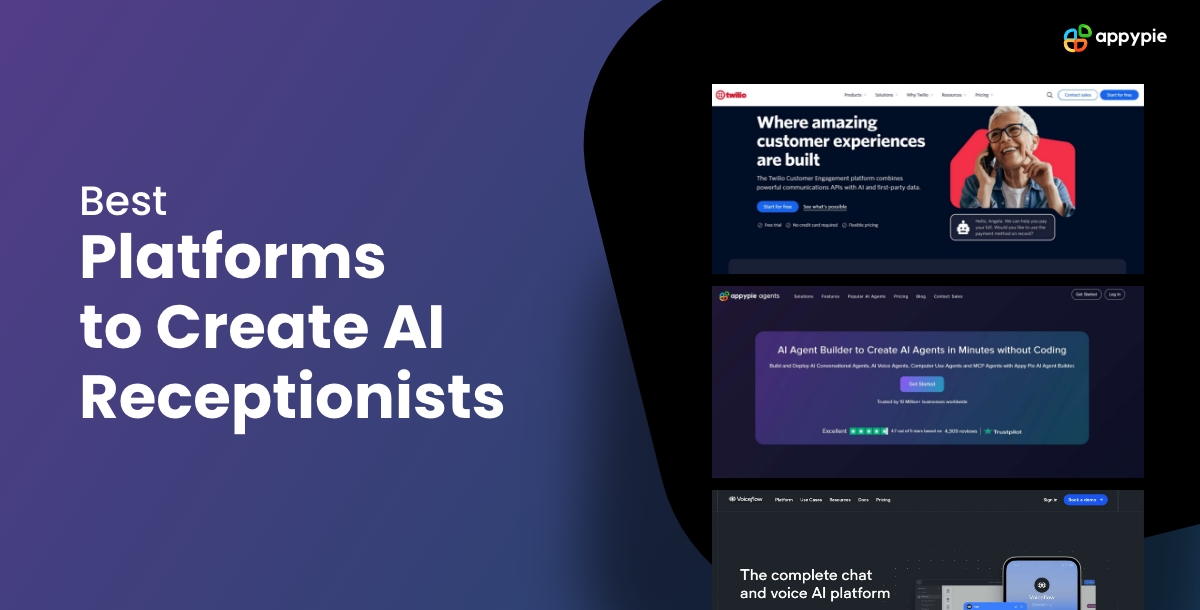7 Best Platforms to Create AI Receptionists

Table of Contents
- What are AI Receptionists?
- What are the Benefits of AI Receptionists?
- What are the Best AI Receptionists?
- Appy Pie Agents
- Dialogflow CX
- Voiceflow
- Twilio Studio
- Smith.ai
- Abby Connect
- My AI Front Desk
- Comparison Table of the Best Platforms to Create AI Receptionists
- Conclusion: Which Platform Should You Use to Create AI Receptionist?
- Frequently Asked Questions about the Best Platforms to Create AI Receptionists
What are AI Receptionists?
Modern teams want round-the-clock coverage without grinding their staff. That’s where an AI receptionist shines—routing inquiries, qualifying leads, and booking appointments while keeping the human team focused on high-value conversations. You’ll free up agents for complex cases, shorten average response times, and maintain consistent tone across touchpoints. As you standardize intake, you also generate clean data for continuous improvement and training.
Getting started is about choosing the right foundations for your channels and workflows. Begin with web chat to validate your greeting, triage, and escalation patterns. When you’re mapping the experience from first hello to successful resolution, a flexible chatbot builder helps you prototype quickly, test guardrails, and document handoff logic before you scale.
AI receptionists are automated assistants that greet visitors, triage questions, collect context, and take next actions such as booking meetings or escalating to humans. They can live on your website, messaging channels, or phone lines and often combine natural language understanding with workflow automation. If you’ve ever wondered what are AI voice agents, think of them as the voice-enabled counterpart that answers and routes calls with natural conversation.
As your scope grows, you’ll evolve from simple FAQs to multi-step concierge tasks that update CRMs, schedule appointments, and verify user details. A capable AI agent builder lets you orchestrate these steps with reusable actions and clear governance. Over time, layer insights from your transcripts and experiments to refine prompts and behaviors, then benchmark against the best AI chat assistants in your space to keep quality rising.
What are the Benefits of AI Receptionists?
Here are the main benefits of AI receptionists:
- 24/7 coverage: Always-on first response without adding headcount. Your assistant greets visitors after hours, answers common questions, and captures callback details so teams arrive to a prioritized queue each morning. This keeps lead capture and customer care moving even during weekends and holidays.
- Faster routing: Qualifies intents, gathers details, and directs people to the right queue. By collecting key fields—like reason for contact, order ID, and urgency—the system can auto-triage to sales, support, or billing. Smart escalation rules ensure emergencies bypass general lanes and reach human agents immediately.
- Lower wait times: Handles repeat questions instantly; frees agents for complex cases. Deflect FAQs such as pricing, hours, or appointment availability while queuing edge cases for specialists. This reduces average handle time (AHT) and improves SLA adherence across busy periods.
- Consistent CX: Unified tone and policy adherence across channels. The assistant follows approved scripts, applies eligibility rules the same way every time, and logs every interaction for review. As brand guidelines evolve, you can update responses centrally and roll out changes everywhere at once.
- Actionable data: Structured transcripts and analytics to improve service quality. Tag intents, spot drop-off points, and track conversions from greeting to booking. Insights reveal where to refine prompts, add FAQs, or create new flows that remove friction from the journey.
Many teams start with web chat and later expand to an AI voice agent for inbound calls. If you’re exploring how to create an AI voice agent, begin with a pilot line covering a few high-volume intents, then widen scope as metrics stabilize. When you’re ready to create ai receptionist experiences across channels, choose a modular platform so you can add telephony, messaging, and advanced automations without rework.
What are the Best AI Receptionists?
Seven widely adopted platforms stand out for capability, reliability, and breadth: Appy Pie Agents, Dialogflow CX, Voiceflow, Twilio Studio, Tidio, Landbot, and My AI Front Desk. Each supports different motions—no-code prototyping, design-first conversation mapping, or phone-centric voice reception—so you can align tooling to channel strategy and operational maturity. Selecting the right AI chatbot builder or agent builder depends on your stack, budget, compliance needs, and expected call/chat volumes.
To keep this practical, we begin with Appy Pie Agents for its accessibility and no-code approach, then progress through conversation-led and telephony-led options that suit contact centers and service businesses. Throughout, we note where a receptionist bot excels, where additional configuration may be required, and how integrations with calendars, CRMs, and analytics shape day-to-day outcomes. We also draw on patterns from teams exploring how to build chatbots with conversational AI to inform architecture choices and rollout plans.
Here’s a closer look at the top contenders:
- Appy Pie Agents — for no-code AI agent building, customizable workflows, and affordable automation at scale.
- Dialogflow CX — for enterprise NLU, stateful flows, and contact-center integrations across chat and telephony.
- Voiceflow — for design-first prototyping, collaborative conversation mapping, and multi-channel exports.
- Twilio Studio — for programmable IVR, serverless logic, and carrier-grade phone routing.
- Smith.ai — for AI-powered call answering with seamless human handoff, lead qualification, and appointment scheduling tailored to business rules.
- Abby Connect — for professional, voice-led reception with reliable intake, message routing, and optional pairing of AI with live receptionists.
- My AI Front Desk — for turnkey phone reception, appointment scheduling, and natural voice experiences.
1. Appy Pie Agents
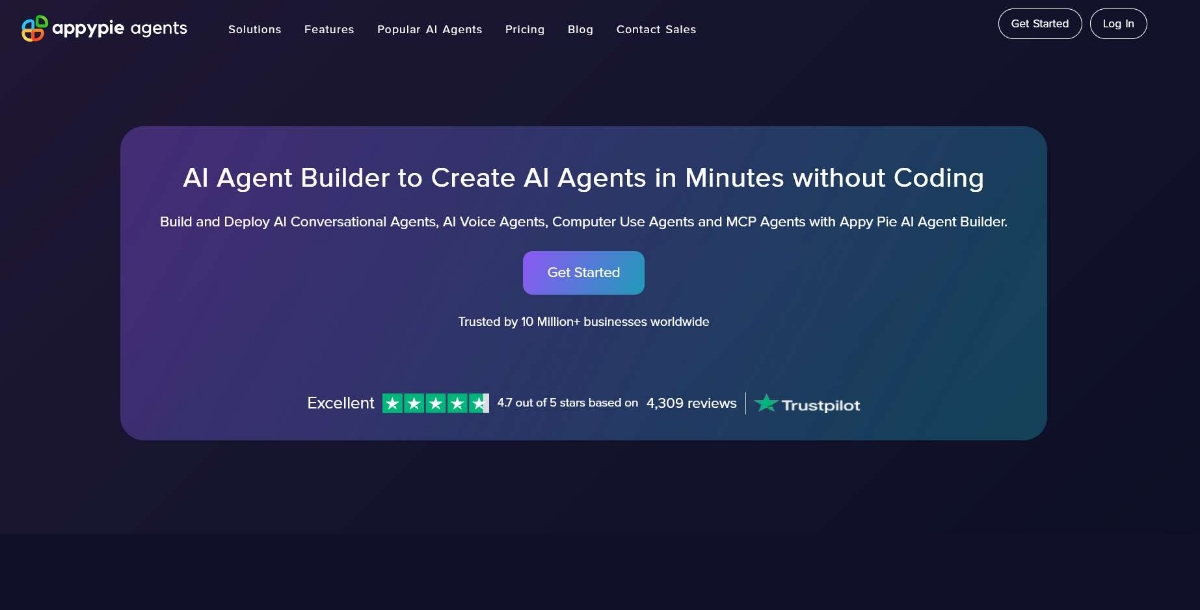
Appy Pie Agents lets you create AI receptionist experiences quickly with a no-code canvas. Connect knowledge sources, define tasks, and hand off to humans via unified inboxes. You can design call-flows or chat journeys, add guardrails, and capture lead data—ideal for teams that want fast setup without engineering overhead.
Best for: SMBs and mid-market teams that want a fast, no-code path from prototype to production across web and messaging.
Pros:
- No-code workflow builder with reusable actions.
- Easy knowledge ingestion for FAQs and policies.
- Human handoff and transcripts out of the box.
- Scales from simple chat to multi-step concierge tasks.
Cons:
- Highly specialized custom logic may require advanced configuration.
- Voice features vary by region and telephony setup.
- Analytics depth depends on connected data sources.
2. Dialogflow CX

Dialogflow CX is Google’s enterprise conversational platform for building stateful, multi-turn assistants across chat and telephony. Its visual flows, parameters, and fulfillment make it practical to deploy a receptionist that greets callers, gathers info, updates CRMs, and transfers to agents when needed.
Best for: Teams that want robust NLU with strong telephony and contact center integrations.
Pros:
- Powerful intent and entity modeling with contexts.
- Native phone integrations via partners and CCaaS stacks.
- Versioning and environments for safe rollouts.
- Rich webhook fulfillment for business logic.
Cons:
- Learning curve for CX concepts and design patterns.
- Costs can rise with traffic and advanced features.
- Requires disciplined conversation design to avoid sprawl.
3. Voiceflow
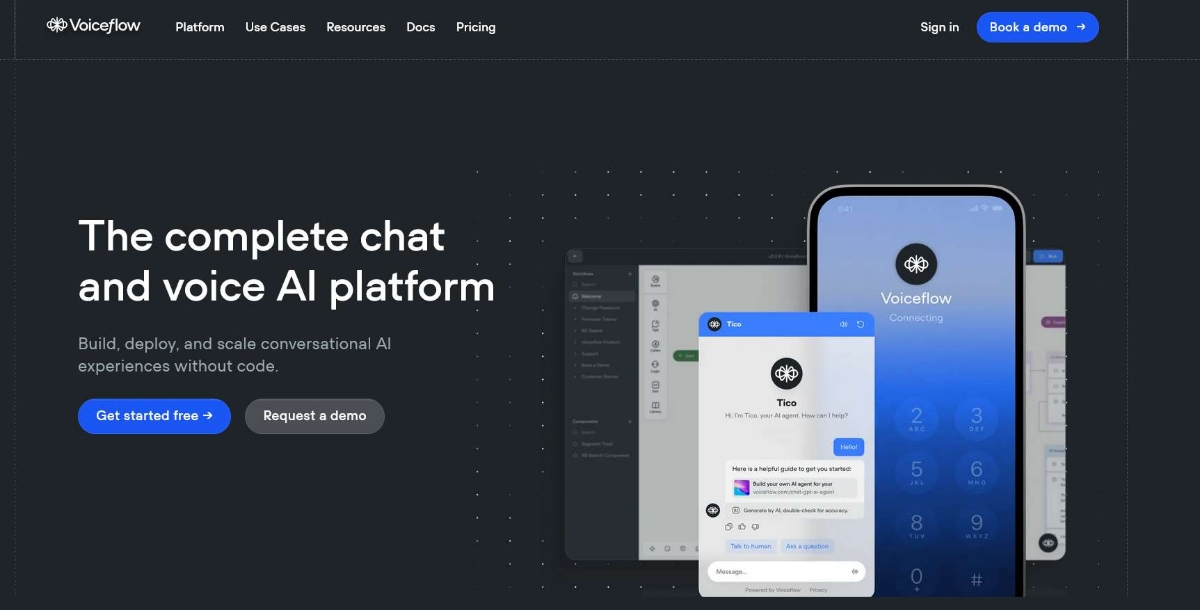
Voiceflow provides a collaborative canvas to design, test, and ship AI receptionists for web chat or phone. Teams storyboard intents, prototype rapidly, and connect to runtime stacks—useful when documenting the “happy path” and edge cases before scaling.
Best for: Design-led teams that need rapid prototyping and stakeholder collaboration for complex assistants.
Pros:
- Visual conversation design with reusable blocks.
- Shared testing and review flows for stakeholders.
- Supports data stores and retrieval for richer context.
- Exports to multiple channels and runtimes.
Cons:
- Production hosting usually requires an external runtime.
- Advanced analytics depend on connected tools.
- Non-designers may need onboarding time.
4. Twilio Studio

Twilio Studio combines visual flows with programmable APIs to power IVR and phone routing, making it ideal when you need a receptionist that answers, verifies callers, collects details, and routes to live agents or queues.
Best for: Engineering-led teams building a robust voice IVR or blended phone/chat concierge.
Pros:
- Carrier-grade telephony and call control.
- Serverless functions for custom logic and integrations.
- Global reach for numbers and compliance options.
- Fine-grained control over call flows and handoff.
Cons:
- Requires developers to unlock full capability.
- Usage-based costs need monitoring at scale.
- Natural dialogs need an added NLU layer.
5. Smith.ai
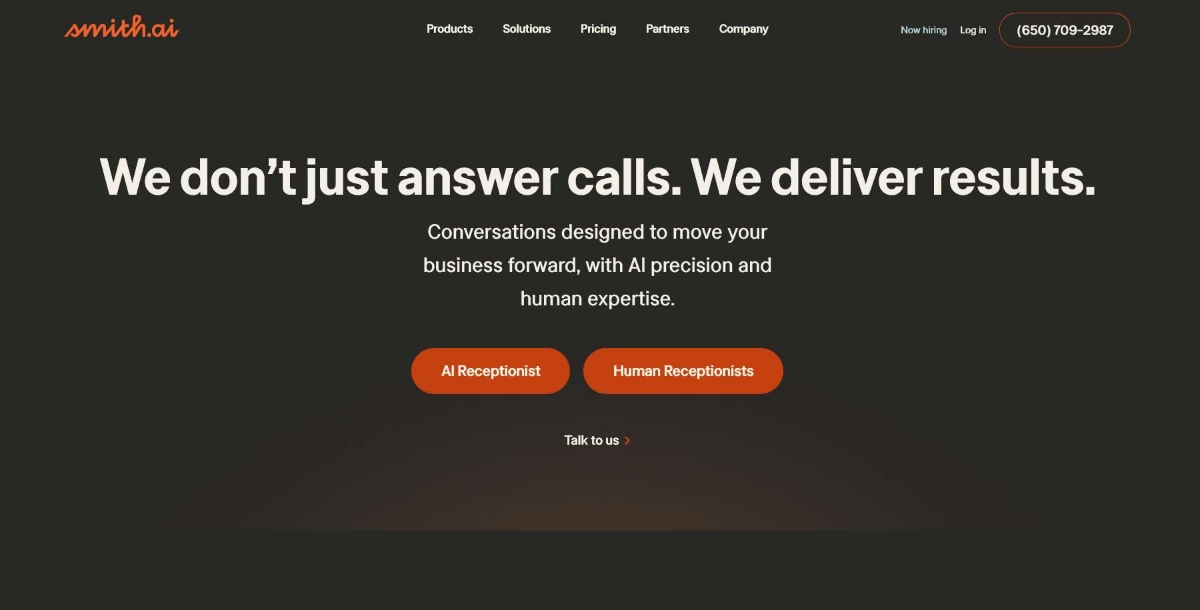
Smith.ai blends AI call handling with human backup to deliver a dependable receptionist experience. It answers and routes calls, qualifies inbound inquiries, books appointments, and can escalate to live agents when situations require a personal touch. Configuration focuses on capturing intent, verifying caller details, and syncing key outcomes to your systems.
Best for: Service-oriented SMBs and professional practices that want a voice-first receptionist with optional human coverage for complex calls.
Pros:
- AI call answering with seamless handoff to trained human agents.
- Lead qualification and intake workflows tailored to business rules.
- Appointment scheduling and message taking to reduce missed opportunities.
- Configurable greetings and caller experiences aligned to brand tone.
Cons:
- Deep customization beyond standard flows may require additional setup.
- Advanced reporting and analytics depend on plan and integrations.
- Costs can scale with call volume and add-on services.
6. Abby Connect
Abby Connect offers an AI receptionist designed to sound natural and handle high call volumes with consistent quality. It greets callers, answers common questions, captures messages, transfers to staff, and supports scheduling scenarios—aimed at creating a polished first impression on every call.
Best for: Firms that prioritize a professional, voice-led front desk with scalable call handling and straightforward setup.
Pros:
- 24/7 automated answering with fast response and no hold times.
- Reliable intake, message routing, and call transfer workflows.
- Configurable prompts to reflect industry and brand specifics.
- Option to pair AI with live receptionists for complex scenarios.
Cons:
- Web chat and multi-channel automation may require separate tools.
- Customization depth varies by supported integrations and plan.
- Heavily specialized logic can need iterative tuning.
7. My AI Front Desk
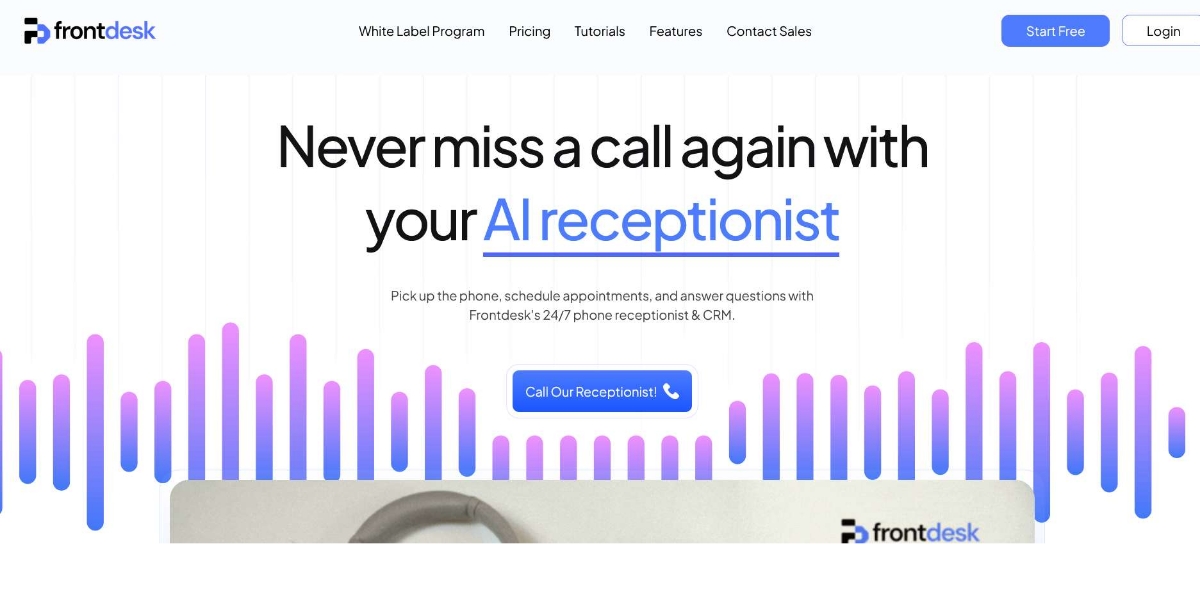
My AI Front Desk specializes in phone-first reception workflows: answering calls, qualifying callers, booking appointments, and handing off to staff when needed. It’s purpose-built for service businesses that want a natural voice experience without building everything from scratch.
Best for: Clinics, salons, and local service providers that prioritize voice reception and appointment scheduling.
Pros:
- Turnkey voice receptionist with appointment booking.
- Caller recognition and context retention for repeat visits.
- Works alongside human staff with clear escalation.
- Optimized prompts for common small-business scenarios.
Cons:
- Focus is voice-first; web chat coverage may require separate tools.
- Customization depth may be narrower than general-purpose platforms.
- Integrations depend on supported calendars and CRMs.
Comparison Table of the Best Platforms to Create AI Receptionists
| Platform | Setup Type | Voice Support | Channels | Notable Features | Best for |
|---|---|---|---|---|---|
| Appy Pie Agents | No-code | Available (region-dependent) | Web, Messaging | Knowledge ingestion, actions, human handoff | SMBs to mid-market |
| Dialogflow CX | Enterprise | Native via partners | Phone, Web, Messaging | Stateful flows, entities, fulfillment | Contact centers |
| Voiceflow | Design-first | Via integrations | Web, Phone (export) | Conversation design, prototyping | Product & CX teams |
| Twilio Studio | Developer-centric | Native telephony | Phone, SMS, WhatsApp | Programmable IVR, serverless hooks | Engineering-led orgs |
| Smith.ai | Turnkey + managed | Yes (phone-first) | Phone (with human handoff) | AI call answering, lead qualification, appointment booking, agent escalation | SMBs & professional services |
| Abby Connect | Turnkey | Yes | Phone | 24/7 automated answering, message routing, configurable prompts, optional live receptionists | Firms needing a polished, voice-led front desk |
| My AI Front Desk | Turnkey | Yes (phone-first) | Phone | Appointment booking, caller context, escalation | Local service businesses |
Conclusion: Which Platform Should You Use to Create AI Receptionist?
If you want the fastest time-to-value, start with Appy Pie Agents and iterate toward your ideal flow. Design-heavy teams that storyboard first will appreciate Voiceflow. When telephony is the priority, Twilio Studio is dependable. Local service businesses that want a ready-made phone concierge should check My AI Front Desk. Landbot and Tidio are nimble choices for lead capture and chat-first funnels, while Dialogflow CX excels when you need deep state management.
Whichever you choose, define target intents and escalation rules early. Pilot on a narrow scope, measure handoff rates, and tune prompts weekly. For teams researching how to create AI voice agent rollouts, stabilize web chat first, then extend to phone. Later, evolve with your preferred AI agent builder—this remains a reliable way to advance from prototype to production and master customer support.
Frequently Asked Questions about the Best Platforms to Create AI Receptionists
1) What is an AI receptionist and how does it work?
An AI receptionist is a virtual assistant that greets customers, answers common questions, routes conversations, and books appointments across channels like web chat and phone. It uses natural language understanding and automation to reduce wait times while escalating complex requests to human staff when needed.
2) How do I choose the right platform to create ai receptionist experiences?
Start by listing your highest-volume intents, target channels, and integration needs (calendar, CRM, help desk). Then compare tools such as Appy Pie Agents, Dialogflow CX, Voiceflow, Twilio Studio, My AI Front Desk, Smith.ai, and Abby Connect based on setup effort, voice support, and governance so you can scale confidently.
3) What’s the difference between a chat receptionist and an ai voice agent?
A chat receptionist handles text interactions on your site or messaging apps, while an ai voice agent answers phone calls, captures intent by speech, and performs actions like transfers or scheduling. Many teams begin with chat, then explore how to create an AI voice agent after the core routing and policies are validated.
4) Any best practices for how to build chatbots with conversational AI for reception use cases?
Design short, clear prompts and define explicit escalation paths to humans for edge cases. Iterate weekly using transcripts and analytics, add guardrails for sensitive topics, and maintain a change log so improvements are traceable from pilot to production.
5) How much does an AI receptionist cost and what should I budget for?
Costs vary by platform and usage—expect a base platform fee plus metered charges for messages or minutes, and potential add-ons for advanced analytics or telephony. Also budget time for conversation design, testing, and ongoing optimization to keep quality high as volumes grow.
Related Articles
- 11 Best Chatbot Software for Enterprise Businesses
- What Are AI Agents? Types, Examples, and How to Build with No-Code
- Top 7 Platforms to Create AI Sales Agents
- 7 Best Platforms to Create AI Recruiters
- What Are Computer Use Agents (CUAs)?
- Best No-Code AI Agent Builders in 2025
- 7 Best Platforms to Create AI Travel Agents
- How to Chat with Gmail Using MCP Agent?
- 50 AI Agents Examples Transforming Industries in 2025
- Best AI Agent Frameworks in 2025: The Ultimate Guide to Building Autonomous AI Agents
- 10 Best Computer Use Agents in 2025
- Best AI Chatbot Builders in 2025
- Best Generative AI Agents in 2025: The Tools Leading Autonomous Intelligence
- What Are AI Voice Agents?
- How to Use Computer Use Agents for Performing Tasks?
